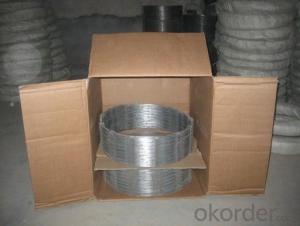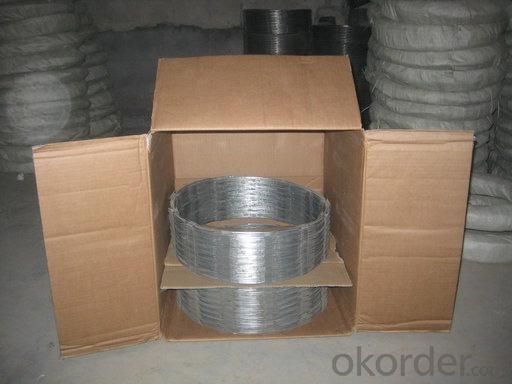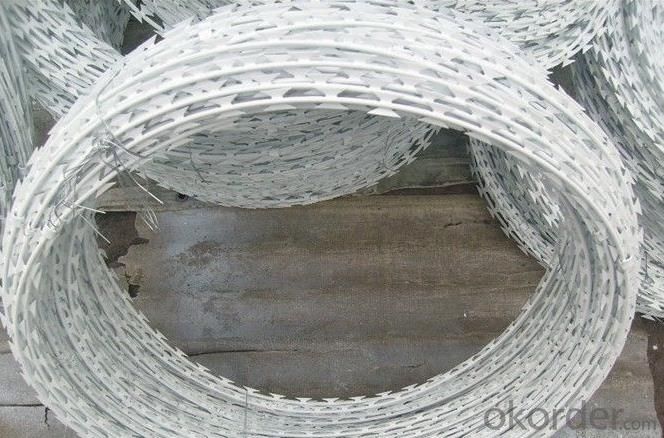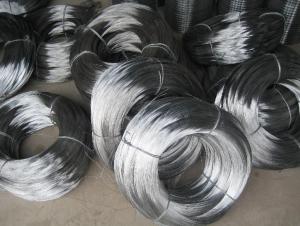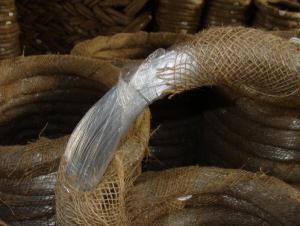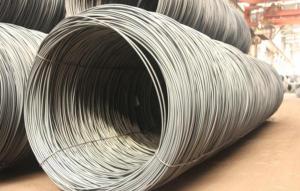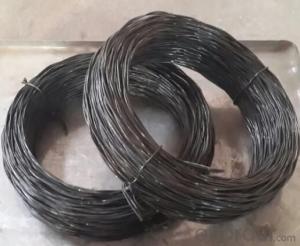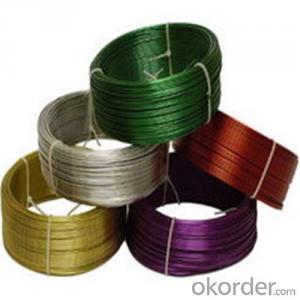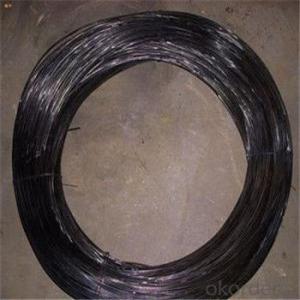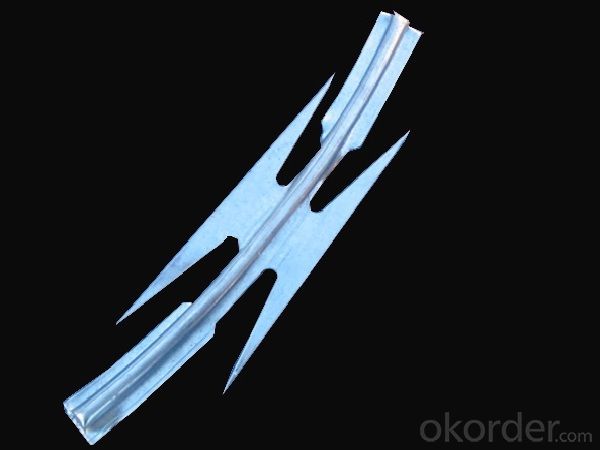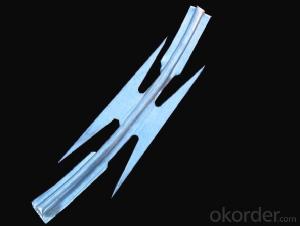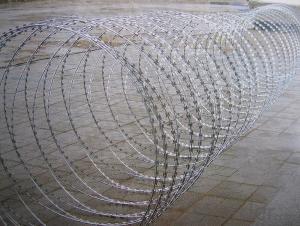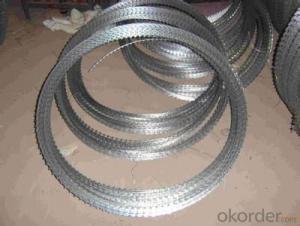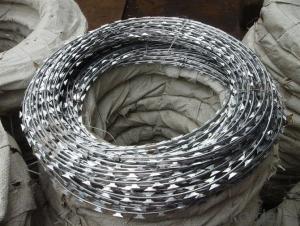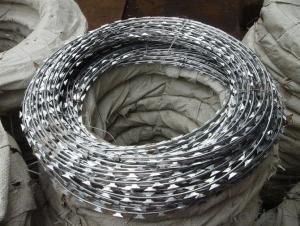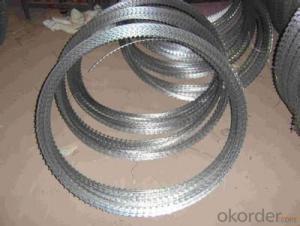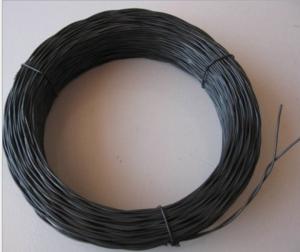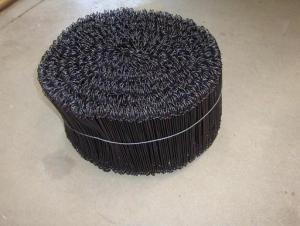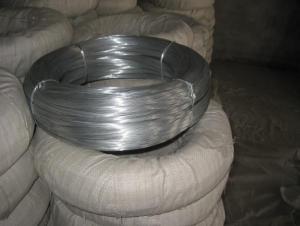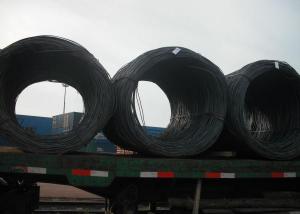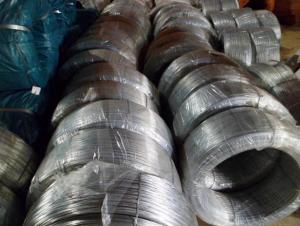GalvanizedRazor Barbed Wire
- Loading Port:
- China Main Port
- Payment Terms:
- TT OR LC
- Min Order Qty:
- -
- Supply Capability:
- -
OKorder Service Pledge
OKorder Financial Service
You Might Also Like
Quick Details
| Place of Origin: | Razor Type: | Model Number: | |||
| Material: | Surface Treatment: | Type: | |||
Packaging & Delivery
| Packaging Detail: | on pallet or as required |
| Delivery Detail: | depend on amount |
Specifications
razor wire/razor coil
widely used in military,gill,prison,bank,communitry fence etc
we also gain ISO9001 certificate
razor wire/razor coil/razor fencing
main material:galvanized plate,stainless steel plate
According to the installation can be divided into:linear razor barbed wire, spiral razor barbed wire, cross type razor barbed wire, flat plate type razor barbed wire
Characteristics: sharp and beautiful razor, high strength core wire, those make the products suitable for prevention,difficult to destroy,easy to installation, aging-resistance,etc
Application: widely used in military, gill prison, government agencies, bank, as well as the living community fence, private houses, villas fence, doors and Windows fence, highway fence, railway fence and border security for protection
specification | Thickness of barbed(mm) | Diameter of core wire(mm) | Longth of razor(mm) | Width of razor(mm) | Distance of razor(mm) |
BTO12 | 0.5±0.05 | 2.5±0.1 | 10±1 | 13±1 | 26±1 |
BTO18 | 0.5±0.05 | 2.5±0.1 | 15±1 | 16±1 | 33±1 |
BTO22 | 0.5±0.05 | 2.5±0.1 | 22±1 | 16±1 | 34±1 |
CBT--65 | 0.5±0.05 | 2.5±0.1 | 65±1 | 21±1 | 100±1 |
- Q: first wire change
- Depends on how many little kinks he's putting in it. Also depends on how fast he works, if your wire needs a lot of work or a little, and if he already has an idea of what he wants to do or if he's just guessing along the way. It shouldn't take longer for him to make the actual kinks than it does the remove and replace the wire. That's a little more labor intensive and can take about 5-10 minutes for each wire. The whole thing, uninterrupted might last 30-45 minutes.
- Q: The wire from the cicuit breaker
- Agreed. 10 ga. You could use 8, but it would be a waste of money and it is much harder to work.
- Q: What are the advantages and disadvantages of a bank wire transfer ?
- its just a transfer of funds from one account to another --- usually overseas --- most intracountry transfers can be accomplished online today ---- it depends on how much you need to transfer and to whom --- there are much easier and cheaper ways to transfer funds --- credit cards, international transfers such as western union, international postal orders ---- have fun
- Q: On the wires leading to existing system I can see the main power lead. However all the other wires are different in color leading to existing valves. From the wire bundle two black wires (the only black wires) lead out to nothing and were left with no electrical end caps protecting. Manual says nothing on wiring valves. Any ideas on black wires? Or how can I splice in to existing system wires at valve point having one valve working at a time when system is operating? Am I going to have to get a new controler or run new wires existing controler?
- As long as you have an extra colored wire and your controller will support the extra valve, it will work. I am wondering why you have 2 black ones though, unless one of them has a stripe. Normally multi-strand wire has only one of each color. To see a wiring diagram, follow the link below
- Q: What's the difference between stainless steel wire and steel wire?
- Metal wire drawing stress state for two to stress was tensile stress to three principal stress state, and it is three to compress the main stress state of stress was compared, the metal wire drawing easier to reach the state of plastic deformation. The deformation state of the drawing is two, the compression deformation is always the three main deformation state of the tensile deformation, which is disadvantageous to the plasticity of the metal material, and it is easy to produce and expose the surface defects. The deformation of wire drawing process is limited by its safety factor, and the number of drawing passes is smaller when the secondary deformation is smaller. Therefore, multi pass continuous high-speed drawing is often used in the production of wire.
- Q: is there a way to wire an exit sign to a plug for an outlet receptacle?
- First off, Aurthur A's answer is composed of several NEC violations; he may be going to electrical hell, if he doesn't shape up. Second, you did not say if this is a required exit sign. If it is, then you will need a licensed electrical contractor to install it; as most jurisdictions will not allow work in anything but the owner's principle dwelling to be done by unlicensed personel.
- Q: i need magnetic wire to make a coil and build aradio
- You can often get varnished wire at an outlet such as radio shack. I have also used the yokes of old TV sets that I usually got for free at a local repair shop. I had to carefully unwind the coils. The wire in an automobile ignition coil is another potentially free source. You can purchase electrical insulating varnish as well. Krylon makes an aerosol variety and most others come in a regular can, but you would have to be creative in dipping the wire and suspending it to dry without damaging the coating.
- Q: I am getting these 2 CVR 12's 4 ohm dvc and i am wiring them for a 2 ohm load (parallel). When you run a wire from voice coil 1 positive to voice coil 2 positive, then to amp. and the same for negative, what is the wire that is connecting the voice coils? is it a power wire, ground wire, speaker wire? please help!
- I'm not sure I understand what you are asking, but 2 4ohm DVC's can't be wired to 2 ohm, either 4ohm or 1 ohm, but you would need a 1 ohm stable amp to do that. As for the other part of the question, can you clarify?
- Q: I have a 2000 Mazda 626, and I am replacing the factory stereo with a Sony CDX-GT66UPW, I tried replacing it earlier and had to cut off the end plastic pieces for the original stereo wires and stripped the wires, So now I am trying to match up the wires from the new stereo with the old colors, But I don't know what color goes to what on the mazda? Can anyone give me a color coded diagram for the wiring?
- 2000 Mazda 626 Car Stereo Radio Wiring Diagram Car Radio Constant 12V+ Wire: Blue/Red Car Radio Ignition Switched 12V+ Wire: Blue/White Car Radio Ground Wire: Chassis Car Stereo Illumination Wire: Red/Black Car Stereo Dimmer Wire: N/A Car Stereo Antenna Trigger Wire: N/A Car Stereo Amplifier Trigger Wire: N/A Front Speakers Size: 6″ x 8″ Speakers Front Speakers Location: Doors Left Front Speaker Wire (+): Green/Orange Left Front Speaker Wire (-): Green/Black Right Front Speaker Wire (+): Green Right Front Speaker Wire (-): Yellow/Green Rear Speakers Size: 6″ x 9″ Speakers Rear Speakers Location: Rear Deck Left Rear Speaker Wire (+): Blue/Green Left Rear Speaker Wire (-): Blue Right Rear Speaker Wire (+): Blue/Black Right Rear Speaker Wire (-): Blue/Orange
- Q: I'm trying to install an aftermarket radio in my 2005 suzuki forenza, but it isn't working. The display on the radio doesn't even light up. I'm thinking that it is because there are some unused wires on the oem harness. There is no plug on the original harness thanks to a previous owner, so an adapter plug is out of the question, so i just need to know what wires should or should not be connected to what other wires. The ones which have no equivalent on the aftermarket radio are: illumination wire, and dimmer wire. If someone could provide some info, that would be awesome. The radio being installed is a sony cdx-gt57up.
- Suzuki Wiring Harness
Send your message to us
GalvanizedRazor Barbed Wire
- Loading Port:
- China Main Port
- Payment Terms:
- TT OR LC
- Min Order Qty:
- -
- Supply Capability:
- -
OKorder Service Pledge
OKorder Financial Service
Similar products
Hot products
Hot Searches
